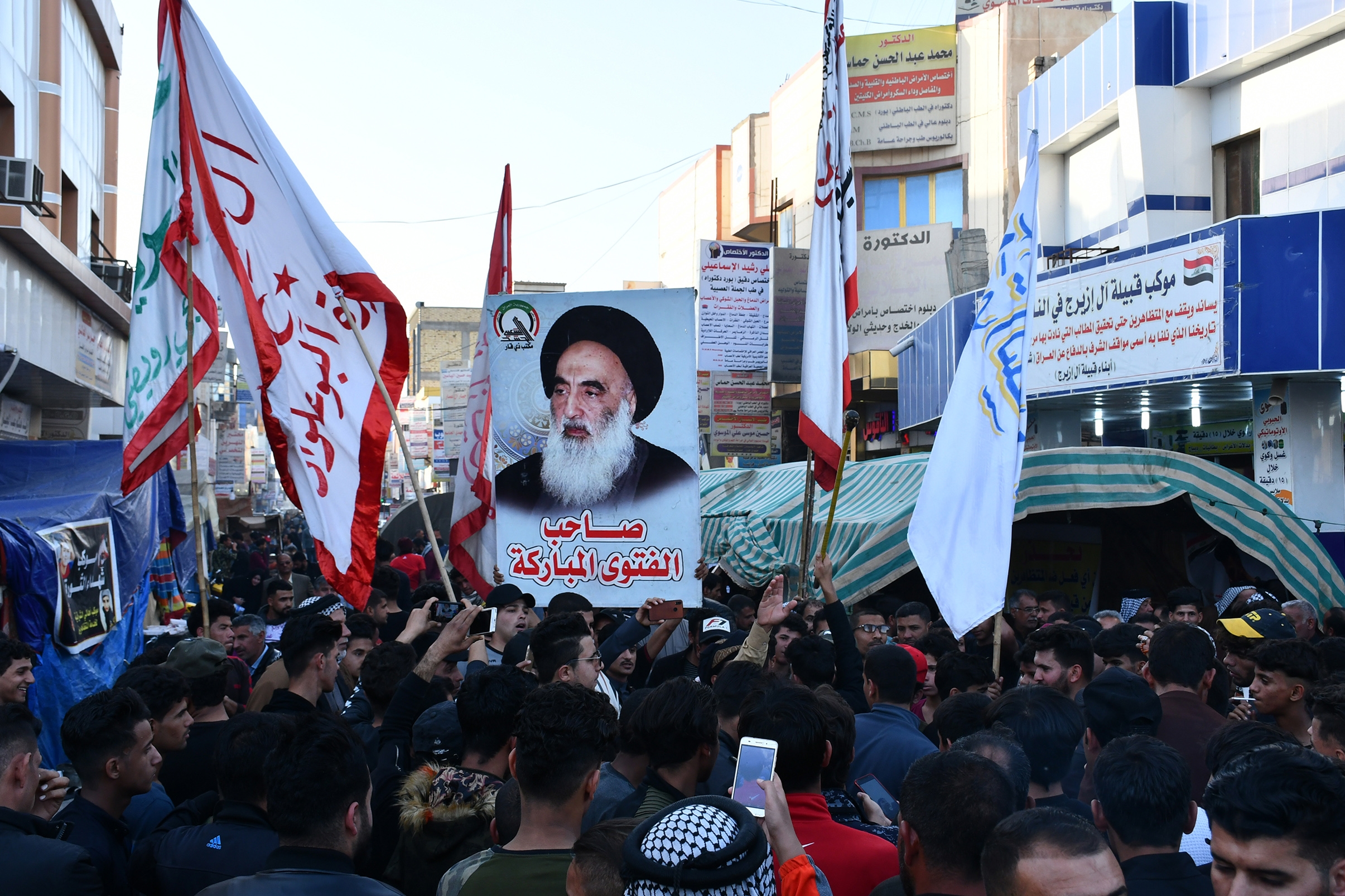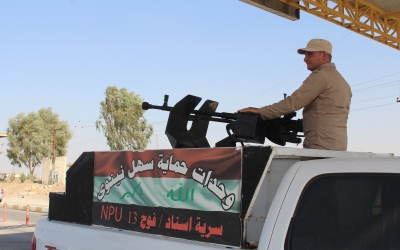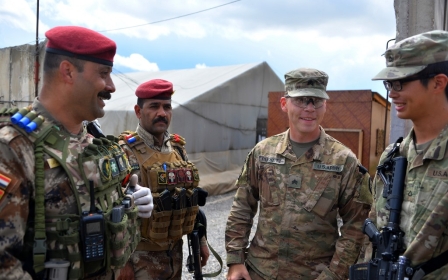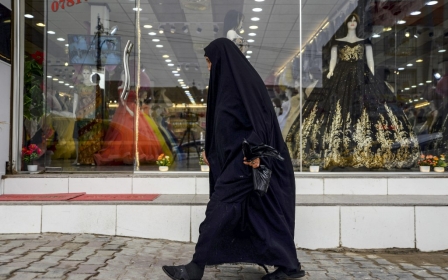Iraqi Shia leader Sistani moves to break Iran's grip over militia movement

An attempt by Grand Ayatollah Ali Sistani to wrest control of Iraq’s Popular Mobilisation Forces from Iranian-backed factions has ended with the national Shia leader giving a green light instead for the dismantling of the militia alliance, military commanders and officials have told Middle East Eye.
That process began last week when four armed factions associated with Sistani, the most senior cleric in the holy city of Najaf, were disengaged from the Popular Mobilisation Authority, which oversees the PMFs, and placed under the direct command of the head of the Iraqi armed forces.
The four factions which were withdrawn were the Imam Ali Brigade, the Ali al-Akbar Brigade, the Abbas Combat Brigade, and the Ansar al-Marjiyya Brigade.
Their withdrawal is significant because the PMA was established by then-Iraqi Prime Minister Nouri al-Maliki in June 2014 to coordinate the response to a fatwa issued by Sistani calling on Iraqis to join the fight against the Islamic State (IS) group.
Sistani’s fatwa was clear that those fighting IS should do so only under the command of the regular Iraqi security forces.
New MEE newsletter: Jerusalem Dispatch
Sign up to get the latest insights and analysis on Israel-Palestine, alongside Turkey Unpacked and other MEE newsletters
But Maliki caused controversy by instead creating the PMA and handing over its leadership to two of Iran’s key allies: his national security adviser Faleh al-Fayyad as president, and Abu Mahdi al-Muhandis, the founder of most of the Iraqi armed factions associated with Iran, as his influential deputy.
On the face of it, Maliki’s move made tactical sense. Iranian-backed Shia militias such as the Badr Organisation, the largest and oldest Iraqi militia, Kataib Hezbollah and Asaib Ahl al-Haq became the backbone of the PMFs (or Hashd al-Shaabi in Arabic), because they were highly organised and well armed.
However, instead of being a regular military force reporting to Iraqi army commanders as required by the PMA’s own law, most of the factions took their orders from Iranian General Qassem Soleimani. The only exceptions were those associated with Sistani and with Shia cleric Moqtada al-Sadr.
Religious authorities in Najaf and Haider al-Abadi, Maliki’s successor as prime minister, tried unsuccessfully to regain control of the PMA over the four years that followed, but fears about an outbreak of intra-Shia fighting meant that these efforts came to nothing.
However, the killings of Soleimani and Muhandis in a US drone strike in January had created a “great and unmissable opportunity" to resume these attempts, a PMA commander told Middle East Eye.
Negotiations hit a dead end
Najaf’s latest effort to bring the PMA under its control was launched six months when it called for most commanders and officials linked to Iran to be replaced with independent commanders under the supervision of Sistani’s office.
However, the refusal of the Iranian-backed commanders to abandon their positions and their insistence on perpetuating Iran's control over the PMA brought negotiations to a dead end.
It was this which pushed Najaf to withdraw its forces and link them "operationally and administratively" to the Office of the Commander-in-Chief directly, according to a political adviser to Adel Abdul Mahdi, Iraq’s current caretaker prime minister, who talked to MEE on condition of anonymity.
“This declares the end of the legitimacy of the existence of the PMA and the start of its dismantling," the adviser said.
“The root of the conflict is that Najaf believes that Iraq was attacked and that these young people [the PMF fighters] volunteered in response to the fatwa. Their mission was to fight IS and defend their families and their lands. They must not be employed politically or militarily in the ongoing conflict between America and Iran.
“But the Iranians insist on continuing to use the PMFs as a tool to pressure the Americans inside Iraq to obtain some gains in their negotiations related to their nuclear programme and to ease the sanctions imposed on them.”
The number of registered fighters to have split from the PMA so far does not exceed 12,000 but commanders and officials told MEE that many thousands more could follow them if Abdul Mahdi agrees to allow the movement of fighters between factions.
The PMA currently has about 150,000 fighters on its books, according to its own figures.
“By withdrawing these factions, which everyone knows are linked directly to him [Sistani], this means he lifts his hands off the PMA,” said Abdul Mahdi’s adviser.
"Keeping the other factions together is a matter of time. This step embarrassed everyone, and once movements between the factions are permitted, tens of thousands of fighters will join the factions that left the organisation.
"Najaf is working to weaken the PMA and force the government to dismantle it in the long run.”
How Sistani’s fatwa saved Maliki
The differences between Najaf and the Iranian-backed factions predate the creation of the PMA.
By early 2014, the majority of Sunni areas in northern and western Iraq had turned against Maliki as a result of the prime minister’s sectarian policies. At the same time, IS was growing in strength and had started launching bold operations against Iraqi security forces.
Maliki, who had lost confidence in the ability of the security forces to confront IS, held a meeting in Baghdad in March 2014 with prominent Shia militia allies to agree on the best ways to secure Baghdad.
But the deployment of the Shia militias in Sunni areas only sharpened sectarian tensions, with nightly reports from rural districts of Baghdad of field executions of Sunni men accused of militancy or family ties to IS.
By June 2014, about a third of Iraqi territory had fallen to IS with security forces routed by the advancing militants.
Sistani's fatwa, issued to address the collapse of the military establishment and prevent IS from taking Baghdad, was the lifeline that Maliki grabbed to legalise the activities of his armed allies by creating the PMA.
Once established, Maliki had good reasons to hand control of the PMA over to his Iranian-backed allies, according to Abdulwahid Toma, a political analyst.
Doing so had “ensured their loyalty on the one hand, and ensured that the Iranians continued to support him,” Toma told MEE.
By then many had already been involved in the fight against IS for several months.
“It was logical for him [Maliki] to hand his allies the leadership of the PMA. The man did not trust his military leaders, and only the Iranians supported him after the international community abandoned him,” said Toma.
'Tens of thousands of followers of Sistani and Sadr joined Badr, Asaib and Kataib Hezbollah, because these factions were the best in terms of financing, weapons and training'
- Hashd commander
Yet while factions such as Kataib Hezbollah and Asaib Ahl al-Haq were effective fighting forces, they were numerically small, functioning more like elite units.
This threatened to prevent the Iranians from assuming full control of the PMFs and “here the conflict began”, PMF commanders told MEE.
Under Soleimani’s leadership, Iran began providing regular salaries to tens of thousands of volunteers as well as arming and equipping them generously. By contrast, armed fighters dependent on Baghdad for their salaries had to wait until June 2015 to be paid.
"Salaries and weapons were the way that Iranian-backed factions recruited volunteers during the first two years after the formation of the PMA,” one pro-Sistani commander told MEE.
"Tens of thousands of followers of Sistani and Sadr joined Badr, Asaib and Kataib Hezbollah, because these factions were the best in terms of financing, weapons and training.”
Meanwhile, Muhandis was using his control of the PMA’s financial and human resources to subdue factions that refused to obey his orders, several PMF commanders told MEE.
In July 2016, Abadi ordered an investigation into Muhandis after he froze the payment of salaries to a number of Sistani-linked brigades.
By then, Najaf had raised concerns with officials in Baghdad and Tehran about the conduct of the Iranian-backed forces, citing their involvement in human rights abuses and seizing resources in areas recaptured from IS.
Muhandis was at the top of the list of leaders that Najaf wanted removed "because he was the cause of all the devastation within the PMA", a pro-Sistani commander told MEE.
In March 2018, Abadi issued a decree ordering the restructuring of the PMFs. But the decree was completely ignored by Muhandis and the Iranian-backed factions.
Within months of Adel Abdul Mahdi succeeding Abadi as prime minister in October 2018, Najaf again called for the PMFs to be restructured and for the PMA to be reformed amid concerns that it could be drawn into a war between Iran and the US.
“US-Iranian tensions were sharpening and Najaf opposes the throwing of the PMFs or any other Iraqi force into this conflict,” Abdul Mahdi’s adviser told MEE.
“Sistani has sent direct and indirect messages to the Iranians and the Americans demanding that they leave Iraq out of it.”
Abdul Mahdi responded by issuing another decree in July 2019, ordering the restructuring of the PMFs and abolishing many positions within the PMA leadership, including Muhandis’s deputy post.
In an effort to appease Muhandis, Abdul Mahdi offered him a new position of chief of staff of the PMFs. Muhandis rejected it on the grounds that it carried no financial or administrative powers.
Crackdown on protesters
Tensions between Najaf and Iran over the PMFs peaked last October when Soleimani, Muhandis and other senior PMA commanders were directly involved in a brutal crackdown targeting anti-government demonstrators, in which hundreds were killed and thousands injured by Iranian-backed factions, some of them operating under the umbrella of the PMA.
"They [Muhandis and Soleimani] turned the PMFs into a sword hanging over the necks of Iraqis. Instead of protecting them, these forces killed or kidnapped them," a pro-Sistani leader said.
"From the first day, we wanted to build a professional national organisation that would be a source of reassurance to all Iraqis and whose mission is defending the country without interfering in political affairs or being subject to the influences of any foreign power."
Following the attacks on protesters, Najaf-associated leaders in November sent a proposal to Abdul Mahdi to reform the PMA and break Iran’s grip over its leadership.
The proposed reforms were based on three initial steps, according to officials and commanders familiar with the discussion.
Firstly, the identification of the positions, directorates and commanders that represent the keys to controlling the PMA. Secondly, the dismissal of those who held those posts and their replacement with new leaders under Najaf’s supervision. And thirdly, the exclusion of all leaders involved in the crackdown on protesters.
But the proposal did not gain any traction. Abdul Mahdi, who resigned later in November at Sistani's request after 32 protesters were killed by security forces in Nasiriyah, would not even discuss it.
"The list of positions they [pro-Sistani factions] demanded and the names they asked to be excluded revealed that they wanted to control the entire commission and this was not reasonable,” a PMA director familiar with the talks, who would have been one of those excluded at Najaf’s behest, told MEE.
“They said that the PMFs were established based on Sistani’s fatwa, so they are entitled to claim these positions, but they forgot that we were fighting in southern and northern Baghdad and southern Fallujah months before the fatwa was issued.”
Chaos follows assassinations
Muhandis continued to exercise his powers as deputy head of the PMA until the last moment of his life.
But the chaos created by his assassination alongside Soleimani saw pro-Sistani leaders launch a fresh bid to press Abdel Mahdi to reform the PMA.
Soon afterwards, Abdul Mahdi met the leaders of the four factions in his office in Baghdad along with Falih Al-Fayadh, his national security adviser and the head of the PMA.
Sheikh Abdul-Mahdi Al-Karbalai and Sayyed Ahmed Al-Safi, Sistani’s most senior representatives and the supervisors of the forces associated with the holy shrines, joined the meeting by phone, one of the attendees told MEE.
Sensing the seriousness of Najaf’s latest efforts to gain control of the PMA, the Iranian-backed factions rushed to name Abdulaziz al-Muhammadawi, known as Abu Fadak, a prominent leader of Kataib Hezbollah, as Muhandis’s successor, but only in the role of chief of staff.
Pro-Sistani leaders refused to appoint Abu Fadak and threatened to withdraw from the PMA if their demands were not taken seriously.
To ease tensions and try to persuade the four factions not to withdraw, Abdul Mahdi sent a military delegation to meet Karbalai “in an attempt to find a settlement that satisfies the two parties”.
But Karbalai refused to go into details and asked members of the delegation to meet Safi instead, commanders from both sides told MEE.
The delegation met Safi and the commanders of the four brigades in Karbala on the same day. The two parties did not reach an agreement, other than to hold further talks.
A few days later, the four commanders met with defence minister Najah Al-Shammari in his office in Baghdad "to discuss some details regarding their exit from the PMA”.
They continued to hold almost daily meetings in Baghdad and Karbala with military leaders, officials and leaders of other PMF factions.
At one stage in the negotiations they were told that the Iranian-backed leaders had agreed to implement Najaf’s demands in return for a “satisfactory settlement for both parties”, one of the attendees told MEE.
But the talks collapsed in Abdul Mahdi’s office in Baghdad last month when the pro-Sistani factions walked out after learning that the Iranian-backed commanders were insisting on appointing Abu Fadak as Muhandis’s successor.
Abdul Mahdi wrote a final time to Karbalai and Safi offering several options to resolve the issues. But by then Najaf had decided to withdraw its forces from the PMA.
‘Nothing has changed’
For now, it remains unclear how the four breakaway factions will be integrated alongside regular Iraqi security forces.
But one proposed project, which was first proposed to Abadi a few years ago, could see them forming a new directorate similar to the Facilities Protection Service (FPS), which is responsible for the security of Iraqi government buildings.
According to the proposal, their mission would be limited to securing the holy shrines of Iraq. If this were to happen, they would report to the interior ministry.
"It is too early to talk about this. We do not want to rush and have not decided on the final form of our alternative project,” a commander of one of the factions told MEE.
“The most important thing is that we have left the PMA. We now work to ensure the continuity of logistical support and to fix all the resulting administrative problems.
“The third step will be to receive the factions and fighters who want to join us then we may announce our project.
“All I can say is that it will be a national integrity formation that will avoid the mistakes of the PMFs and protect people.”
Muhanad al-Aqabi, the director of PMA media, told MEE that all PMF forces were linked to the Iraqi armed forces “administratively and operationally”.
“Therefore this decision will not change anything and will not affect the budget or movements of any of the remaining factions. We are subject to any decision issued by the Commander in Chief of the Armed Forces, but we have not yet received any instructions regarding these brigades. Practically, nothing has changed.”
Middle East Eye delivers independent and unrivalled coverage and analysis of the Middle East, North Africa and beyond. To learn more about republishing this content and the associated fees, please fill out this form. More about MEE can be found here.






